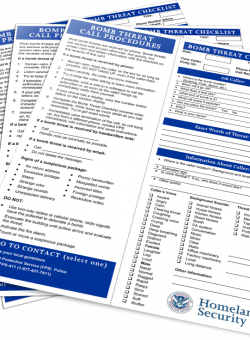ARTICLES
What to Do - Bomb Threat
The guidance below outlines in-depth procedures for responding to receiving a bomb threat and finding a suspicious item. Read on and utilize these resources to prepare yourself so you can react appropriately during such events.
If you receive a bomb threat...
Bomb threats are most commonly received via phone, but are also made in person, via email, written note, or other means. Every bomb threat is unique and should be handled in the context of the facility or environment in which it occurs. Facility supervisors and law enforcement will be in the best position to determine the credibility of the threat. Follow these procedures:
- Remain calm.
- Notify authorities immediately:
- Notify your facility supervisor, such as a manager, operator, or administrator, or follow your facility's standard operating procedure. (See below for assistance with developing a plan for your facility or location.)
- Call 9-1-1 or your local law enforcement if no facility supervisor is available.
- Refer to the Department of Homeland Security (DHS) Bomb Threat Checklist for guidance, if available.
- For threats made via phone:
- Keep the caller on the line as long as possible. Be polite and show interest to keep them talking.
- DO NOT HANG UP, even if the caller does.
- If possible, signal or pass a note to other staff to listen and help notify authorities.
- Write down as much information as possible—caller ID number, exact wording of threat, type of voice or behavior, etc.—that will aid investigators.
- Record the call, if possible.
- Be available for interviews with facility supervisors and/or law enforcement.
- Follow authorities’ instructions. Facility supervisors and/or law enforcement will assess the situation and provide guidance regarding facility lock-down, search, and/or evacuation.
